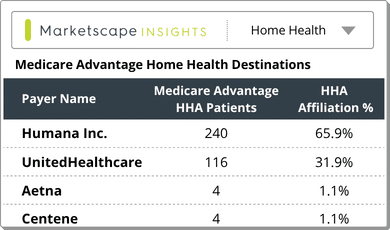Carter Bakkum, Senior Data Analyst, Healthcare Insights
Carter is a senior data analyst who works to turn complex, messy data into actionable intelligence. Carter studied economics and statistics at the University of Virginia before joining an economic consulting firm, where he supported expert testifying economic witnesses on behalf of fortune 500 healthcare companies. After the significant changes in the importance of data analytics during the pandemic, Carter joined the Trella team to dive deeper into the numbers to uncover the stories that drive our experience.Hospital Discharges to Post-Acute Care’s Adherence
By Carter Bakkum | May 3, 2022
Ensuring patient adherence to inpatient discharge instructions are a key avenue for post-acute care agencies to grow admissions

Beneficiary adherence to inpatient discharge instructions to post-acute care agencies is a crucial aspect of a patient’s care pathway. Nearly 1 in 10 patients instructed to enter hospice care were not admitted to a hospice agency within 30 days of inpatient discharge, while 3 in 10 patients instructed to pursue home health care services did not adhere. These patients may have fallen through the cracks in the transition of care and represent an underserved population that PAC agencies can immediately access through referral partnerships. Referral partnerships with facilities in a PAC agency’s market can increase adherence rates, resulting in lower readmission rates for patients discharged from an inpatient stay. Home health agencies decrease the 30-day readmission rate of patients who adhere to PAC instructions by three percentage points compared to non-adherents. Post-acute care agencies should continue to build referral relationships with inpatient facilities to increase adherence rates to post-acute discharge instructions.
Numerous beneficiaries enter post-acute care agencies after inpatient discharge regardless of instructions

Shockingly, only half of the episodes discharged from an inpatient stay that entered hospice care within 30 days were instructed to do so. Further, inpatient discharges that were instructed to enter home health care represent only 56.7% of episodes that entered home health care within 30 days of inpatient discharge. It’s unclear whether these patients sought home health and hospice care of their own volition or received instructions while in another care setting, though the rate of episodes entering post-acute care indicates an imperative for PAC agencies to aid inpatient facilities on the identification of patients that should enter PAC care. The PAC industry provides crucial care for beneficiaries after an inpatient stay. In addition to working with inpatient facilities to ensure adherence to discharge instructions, PAC agencies must advise referral partners on how to identify beneficiaries that are appropriate for post-acute care.
Further investigations into post-acute care trends
This blog leveraged much of its information from Trella’s Industry Trend Report. For more insights on trends in the post-acute industry and how you can use data to drive strategic decision-making, download the full Industry Trend Report here. For more analyses into Medicare data and how data illustrates the importance of post-acute care and how to take advantage of changing healthcare, all my analyses are saved on my author page, linked here.













